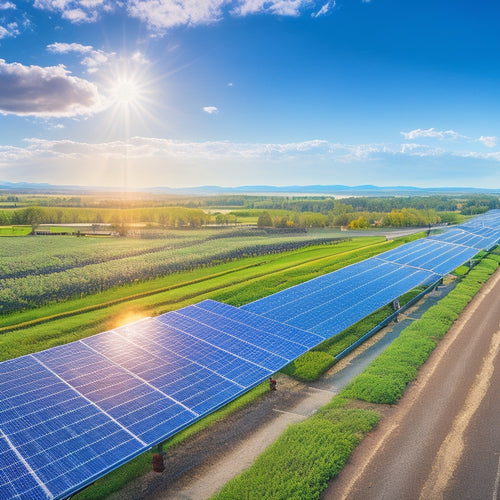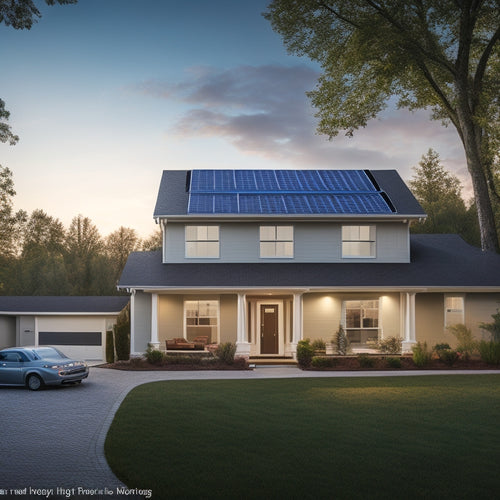
3 Best DIY Panel Installation Tips
Share
When tackling a DIY solar panel installation, you'll want to assess your roof's energy potential by analyzing its solar exposure, orientation, and obstacles, and employ online tools or consult with professionals for an accurate assessment. Next, plan for efficient energy flow by optimizing your solar orientation, correcting panel direction, and adjusting tilt for maximum energy capture. Finally, ascertain safe and secure mounting by using high-quality materials, durable mounting materials, and adhering to local building codes and manufacturer's instructions to guarantee a successful project - and with these foundational steps in place, you'll be well on your way to utilizing the full potential of your solar panels.
Overview
- Analyze your roof's solar exposure, considering orientation, slope, and obstacles, to maximize energy potential.
- Optimize solar panel orientation and tilt (30-40 degrees) for efficient energy capture, with flexible options for ground-based installations.
- Use high-quality, durable materials (anodized aluminum or stainless steel) that can withstand harsh weather and heavy loads.
- Ensure a safe and secure installation by adhering to local building codes and manufacturer's instructions.
- Take necessary safety precautions, including gloves, safety glasses, and harnesses, during the installation process.
Assess Your Roof's Energy Potential
Determine your roof's solar exposure by analyzing its orientation, slope, and surrounding obstacles. This will help you identify the ideal locations for your solar panels.
You'll want to assess the solar orientation of your roof, considering the direction it faces and the angle of the sun's rays. A south-facing roof with minimal shading is ideal.
Consider the importance of structural soundness of roofs before installing your solar panels. Conduct a shading analysis to identify any obstructions, such as trees or neighboring buildings, that could block sunlight.
Consider using online tools or consulting with a professional to get an accurate assessment. By understanding your roof's energy potential, you'll be able to maximize your solar panel's energy output and enjoy the freedom of generating your own clean energy.
Plan for Efficient Energy Flow
How can you guarantee that the energy generated by your solar panels is efficiently captured and employed? It starts with optimizing your solar orientation.
Make sure your panels face the correct direction to maximize energy production. In the northern hemisphere, a south-facing orientation is ideal, while in the southern hemisphere, a north-facing orientation is best.
Ground-based installations offer flexibility in panel orientation and tilt, enhancing energy production. Additionally, consider the tilt of your panels, as this affects energy efficiency. A tilt between 30-40 degrees is recommended for most locations.
Ensure Safe and Secure Mounting
You've invested time and money in your solar panel system, and now it's crucial to guarantee it's safely and securely mounted to reap the benefits.
When it comes to mounting, you'll need high-quality materials that can withstand various environmental conditions, such as harsh weather conditions and heavy snow loads.
Choose durable mounting materials, such as anodized aluminum or stainless steel, that can support the weight of your panels.
Additionally, consider the type of roof you have, as older roofs may require reinforcement for solar installation, and verify your roof is structurally sound and can handle the added weight of the panels.
Always follow local building codes and manufacturer's instructions to avoid any potential risks.
Don't forget to wear safety equipment like gloves, safety glasses, and a safety harness to prevent accidents.
Frequently Asked Questions
What Is the Recommended Wire Size for DIY Solar Panel Installation?
When choosing a wire size for your DIY solar panel installation, you'll want to guarantee it's safe and efficient. Opt for a minimum 10 AWG (American Wire Gauge) wire to minimize energy loss and prioritize installation safety, giving you the freedom to utilize the sun's power reliably.
Can I Mix and Match Different Solar Panel Brands?
When mixing and matching different solar panel brands, you'll need to guarantee solar panel compatibility, considering factors like voltage, current, and connectors. Compare brand performance to guarantee seamless integration, but be aware that warranties might be voided if not paired with same-brand equipment.
How Often Should I Clean My Solar Panels?
Give your solar panels some TLC by cleaning them every 6-12 months, depending on your location's pollution and debris levels, to guarantee peak energy harvesting and prolong their lifespan through diligent solar panel maintenance.
Are DIY Solar Panel Installations Eligible for Tax Credits?
You're wondering if your DIY solar panel installation is eligible for tax credits. Yes, you're eligible as long as you meet IRS requirements; the credit covers 26% of your installation cost, giving you freedom from high energy bills and a lower tax burden.
Do I Need a Permit for a DIY Solar Panel Installation?
Coincidentally, just as you're utilizing the power of the sun, your local government wants to make certain your DIY solar panel installation meets solar panel regulations. You'll likely need a permit to confirm installation safety, so check with your local authorities before you start.
Ready to Buy
As you complete your DIY panel installation, remember that every carefully planned and securely mounted panel is a brick laid on the path to energy independence. With each connection, you're forging a bond between your home and the sun, utilizing its power to fuel your daily life. Your roof, once a passive observer, now becomes an energetic gateway to a sustainable future.
Related Posts
-

How to Achieve a Zero-Waste Lifestyle for a Greener Tomorrow
To achieve a zero-waste lifestyle, start by adopting the principles of refusing, reducing, reusing, and recycling. Sw...
-

Applications of Photovoltaic Systems
Photovoltaic systems are versatile, converting sunlight into electricity for various applications. You can use them i...
-

Cost of Solar With Battery Backup
You're investing in a solar panel system with battery backup to guarantee reliable power during outages. The cost of ...


